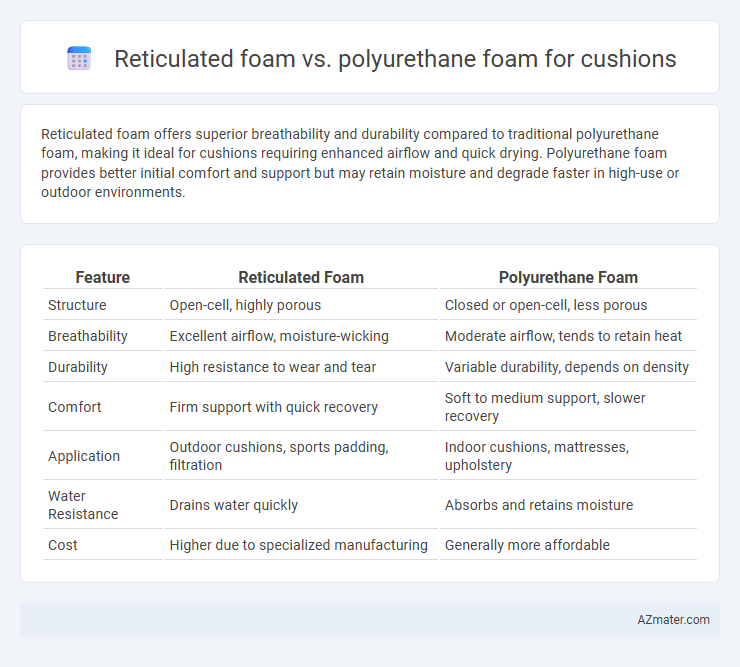Reticulated foam offers superior breathability and durability compared to traditional polyurethane foam, making it ideal for cushions requiring enhanced airflow and quick drying. Polyurethane foam provides better initial comfort and support but may retain moisture and degrade faster in high-use or outdoor environments.
Table of Comparison
| Feature | Reticulated Foam | Polyurethane Foam |
|---|---|---|
| Structure | Open-cell, highly porous | Closed or open-cell, less porous |
| Breathability | Excellent airflow, moisture-wicking | Moderate airflow, tends to retain heat |
| Durability | High resistance to wear and tear | Variable durability, depends on density |
| Comfort | Firm support with quick recovery | Soft to medium support, slower recovery |
| Application | Outdoor cushions, sports padding, filtration | Indoor cushions, mattresses, upholstery |
| Water Resistance | Drains water quickly | Absorbs and retains moisture |
| Cost | Higher due to specialized manufacturing | Generally more affordable |
Introduction to Cushion Foam Types
Reticulated foam features an open-cell structure that enhances airflow, making it highly breathable and ideal for cushions requiring moisture control and quick drying. Polyurethane foam, commonly used in cushions, offers a dense and supportive material providing comfort and durability across various furniture applications. Choosing between reticulated and polyurethane foam depends on factors like desired breathability, support level, and environmental exposure.
What is Reticulated Foam?
Reticulated foam is a highly porous, open-cell material made by removing the cell faces from polyurethane foam, resulting in a skeletal structure with enhanced airflow and drainage properties. This foam type provides superior breathability, quick drying, and resistance to mold and mildew, making it ideal for cushions exposed to moisture or outdoor conditions. Compared to traditional polyurethane foam, reticulated foam offers increased durability and comfort for applications requiring enhanced ventilation and water flow.
What is Polyurethane Foam?
Polyurethane foam is a versatile, synthetic foam widely used for cushioning due to its excellent durability, flexibility, and shock-absorbing properties. It is produced through the chemical reaction of polyols and diisocyanates, creating a lightweight material that provides consistent support and comfort in furniture and mattresses. Compared to reticulated foam, polyurethane foam offers a smoother texture and higher density options, making it ideal for applications requiring both softness and resilience.
Structural Differences Between Reticulated and Polyurethane Foam
Reticulated foam features an open-cell structure with over 90% of cell walls removed, allowing superior airflow and enhanced drainage, making it ideal for applications requiring breathability and quick drying. Polyurethane foam has a closed-cell or semi-open-cell configuration, providing higher density and cushioning support but reduced permeability compared to reticulated foam. These structural differences impact durability, compressibility, and moisture management, influencing their suitability for cushions in various environments.
Breathability and Air Flow in Cushion Foams
Reticulated foam offers superior breathability and air flow compared to traditional polyurethane foam due to its open-cell structure that allows air to pass freely, reducing heat buildup and moisture retention in cushions. Polyurethane foam, with its closed-cell or semi-open-cell composition, tends to trap heat and moisture, resulting in less effective ventilation and potential discomfort during extended use. For applications requiring enhanced ventilation and moisture management, reticulated foam cushions provide optimal comfort by promoting continuous air circulation.
Durability and Longevity Comparison
Reticulated foam offers superior durability due to its open-cell structure that allows better air flow and faster drying, making it resistant to mold and mildew compared to polyurethane foam. Polyurethane foam tends to degrade faster under continuous compression and exposure to moisture, resulting in reduced lifespan and loss of cushioning support. For applications requiring prolonged durability and moisture resistance, reticulated foam provides enhanced longevity and maintains structural integrity significantly longer than conventional polyurethane foam.
Comfort and Support: User Experience
Reticulated foam offers superior breathability and durability, making it ideal for cushions that require consistent support and long-term comfort. Polyurethane foam provides a softer, more affordable option with good initial comfort but tends to lose shape and support over time. Users often prefer reticulated foam for extended seating because it maintains firmness and airflow, enhancing overall cushion performance.
Water Resistance and Drainage Capabilities
Reticulated foam offers superior water resistance and enhanced drainage capabilities compared to standard polyurethane foam, making it ideal for outdoor cushions and marine applications. Its open-cell structure allows rapid water flow and air circulation, preventing moisture buildup and promoting quick drying. Polyurethane foam, with its closed-cell design, tends to retain water, leading to potential mold and odor issues over time.
Typical Applications for Reticulated vs. Polyurethane Foams
Reticulated foam is commonly used in filtration, acoustic insulation, and cushioning applications requiring high airflow and rapid drainage, such as air filters, speaker covers, and medical cushions. Polyurethane foam is preferred for general-purpose cushioning in furniture, automotive seats, mattresses, and packaging due to its excellent comfort, durability, and versatility. Reticulated foam's open-cell structure makes it ideal for applications needing breathability and fluid permeability, while polyurethane foam's closed-cell design offers superior shock absorption and support.
Which Foam is Best for Your Cushion Needs?
Reticulated foam offers superior airflow and water drainage, making it ideal for outdoor cushions and applications requiring breathability and quick drying. Polyurethane foam provides excellent support and comfort for indoor cushions, with a softer feel and good durability over time. Choosing the best foam depends on your specific cushion needs, whether prioritizing ventilation and moisture resistance or comfort and resilience.

Infographic: Reticulated foam vs Polyurethane foam for Cushion
 azmater.com
azmater.com